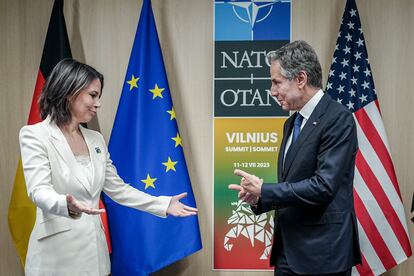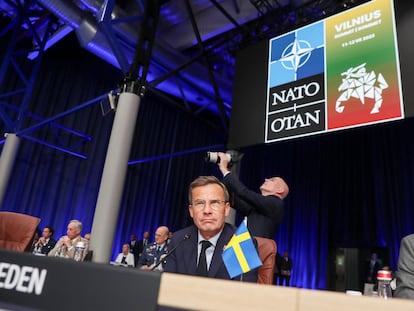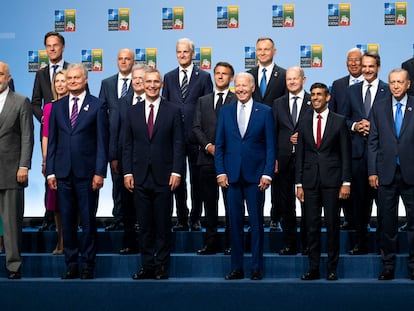New defense plans, China and undersea cables: The key conclusions of the NATO summit beyond Ukraine
In a communiqué, the Allies say defense spending will be ‘at least’ 2% of GDP and announce further investigation into emerging threats in the southern flank

The NATO summit in Vilnius is marked by the relationship between the Allies and Ukraine, with the focus on Kyiv’s possible future accession. But the final communiqué approved Tuesday by the 31 NATO leaders also contains important conclusions in other areas. Here is a summary of the main ones:
Regional defense plans
The Allies have approved a “new generation of regional defense plans” that outline the defense and deterrence mechanisms to face different threats, both hybrid and conventional. NATO Secretary-General Jens Stoltenberg underscored that this was the most significant overhaul of defense plans since the end of the Cold War. The plans, as announced by EL PAÍS, are divided into three geographical areas, which seek to deal with the main threats to the Alliance: Russia and terrorism. The new plans cover five areas of threats and attacks: land, air, maritime, cyber and space domains. In addition, the 4,000-page secret document also describes the tasks that each of the Allies will be responsible for, outlining the specific areas in need of protection and what equipment can be used for this purpose.
Defense spending
The Vilnius summit conclusions also formalized the renewed goal to increase investment in defense. In 2014, the Allies approved a communiqué in which members that were not spending 2% of gross domestic product (GDP) on defense committed to reaching this goal in a decade, a deadline which comes up next year. In the latest communiqué, the wording has changed to “at least” 2% of GDP. During the summit, Stoltenberg stressed that great advances had been made with respect to spending, stating that European members of NATO and Canada were projected to increase investment by 8% in 2023 compared to the previous year.
China
The rise of China has raised concern in NATO, with many members worried about what they consider to be its assertiveness and repressive policies. Last year, NATO included China in the Strategic Concept approved at the Madrid summit, and this year, it outlined that the Allies are working together “to address the systemic challenges posed by China.” “We will stand up for our shared values and the rules-based international order, including freedom of navigation,” said the communiqué.
But the Allies are divided on how far NATO should go when it comes to China. The United States is keen to use NATO against China and to build strong links with Asian democracies, while European countries, led by Germany and France, are more hesitant. The statement, however, makes it clear that China is on NATO’s horizon.
Southern flank
The statement also contains a reference to the southern flank, which is a matter of greatest interest to countries such as Spain and Italy. The communiqué acknowledges the high level of instability in the Sahel, North Africa and Middle East. And it points out that Russia is trying to fuel tensions in these areas. In response, the Allies have agreed to commission the North Atlantic Council, NATO’s representative body, to launch a “comprehensive and deep reflection on existing and emerging threats and challenges, and opportunities for engagements with our partner nations, international organizations, and other relevant actors in the region.”
Sweden’s accession
The statement welcomes Sweden as a full member of NATO. This was made possible after Turkey made a surprise pledge to drop its opposition to Sweden joining the Alliance on Monday. However, given Turkish President Recep Tayyip Erdoğan’s rocky record, some Allies have preferred to err on the side of caution, fearing he may do a U-turn. What’s more, Sweden’s accession to NATO must also be ratified by the Turkish Parliament. But given the deal has been announced and included in NATO final communiqué, it is unlikely that Erdoğan will back down.
Strategic infrastructure
The statement also focuses on the growing concerns over the fragility of certain key infrastructure, including undersea cables. According to NATO, “the threat to critical undersea infrastructure is real and it is developing.” In response, NATO states that “any deliberate attack against Allies’ critical infrastructure will be met with a united and determined response.” The communiqué also announced that the Allies have agreed to establish a Maritime Center for the Security of Critical Undersea Infrastructure, and set up a network that brings together NATO, allies, the private sector and other relevant actors to improve information sharing.
Sign up for our weekly newsletter to get more English-language news coverage from EL PAÍS USA Edition
Tu suscripción se está usando en otro dispositivo
¿Quieres añadir otro usuario a tu suscripción?
Si continúas leyendo en este dispositivo, no se podrá leer en el otro.
FlechaTu suscripción se está usando en otro dispositivo y solo puedes acceder a EL PAÍS desde un dispositivo a la vez.
Si quieres compartir tu cuenta, cambia tu suscripción a la modalidad Premium, así podrás añadir otro usuario. Cada uno accederá con su propia cuenta de email, lo que os permitirá personalizar vuestra experiencia en EL PAÍS.
¿Tienes una suscripción de empresa? Accede aquí para contratar más cuentas.
En el caso de no saber quién está usando tu cuenta, te recomendamos cambiar tu contraseña aquí.
Si decides continuar compartiendo tu cuenta, este mensaje se mostrará en tu dispositivo y en el de la otra persona que está usando tu cuenta de forma indefinida, afectando a tu experiencia de lectura. Puedes consultar aquí los términos y condiciones de la suscripción digital.
More information
Archived In
Últimas noticias
There is as much life left to discover on planet Earth as that which is already known
Dozens presumed dead, around 100 injured in fire at Swiss Alps bar during New Year’s celebration
Is porn for women different from conventional porn? We spoke to those who make it
Cartagena de Indias is sinking: What can the city do to mitigate it?
Most viewed
- David King, chemist: ‘There are scientists studying how to cool the planet; nobody should stop these experiments from happening’
- Reinhard Genzel, Nobel laureate in physics: ‘One-minute videos will never give you the truth’
- Oona Chaplin: ‘I told James Cameron that I was living in a treehouse and starting a permaculture project with a friend’
- Sinaloa Cartel war is taking its toll on Los Chapitos
- The Interoceanic Train, the Mexican alternative to the Panama Canal










































